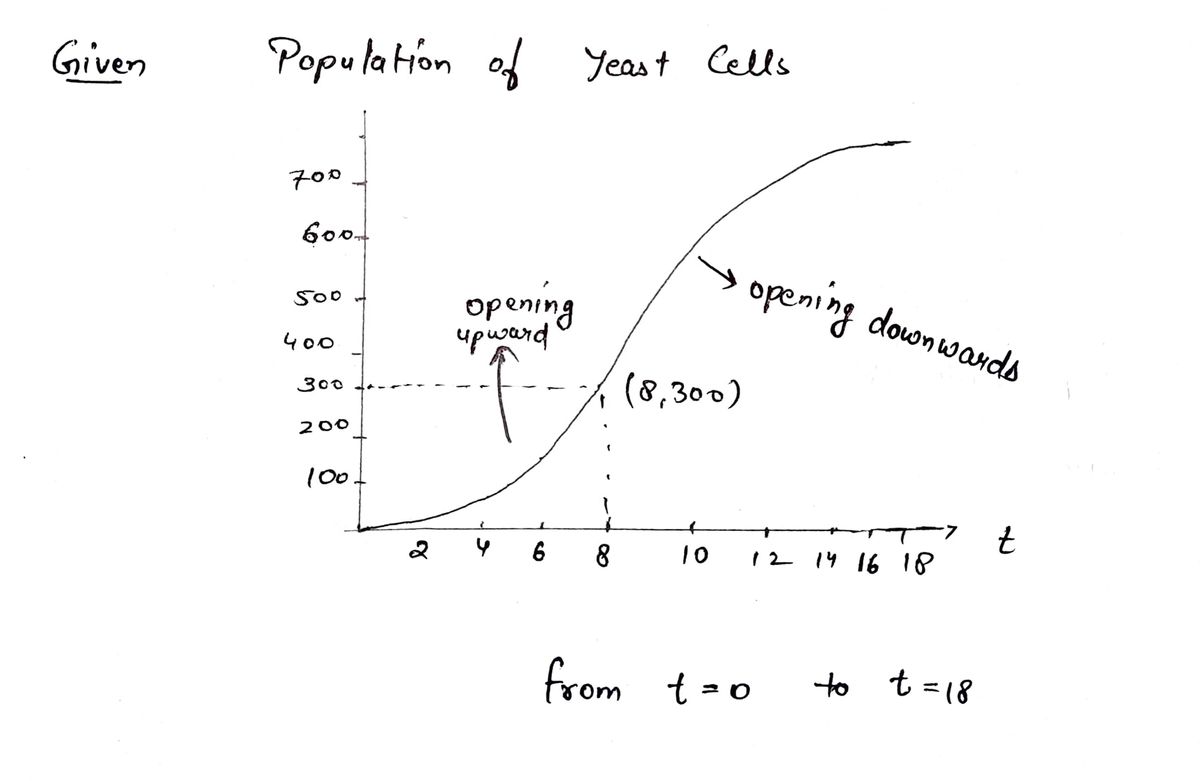A graph of a population of yeast cells in a new laboratory culture as a function of time from t = 0 to t = 18 is shown. Number of yeast cells y 700 600 500 400 300 200 100 0 0 (t, y) = 2 L 4 6 8 10 12 14 16 18 Time (in hours) (a) Describe how the rate of population increase varies. The rate of increase of the population is initially very large, then gets smaller until it reaches a minimum at about t = 8 hours, and increases toward 0 as the population begins to level off. The rate of increase of the population is initially very small, then gets larger until it reaches a maximum at about t = 18 hours. O The rate of increase of the population is consistently large. O The rate of increase of the population is initially very small, then gets larger until it reaches a maximum at about t = 8 hours, and decreases toward 0 as the population begins to level off. The rate of increase of the population is consistently small. (b) At what point is the rate of population increase the highest? t (c) On what interval(s) is the population function concave upward? (Enter your answer using interval notation.) On what interval(s) is the population function concave downward? (Enter your answer using interval notation.) (d) Estimate the coordinates of the inflection point. (t, y) = (
A graph of a population of yeast cells in a new laboratory culture as a function of time from t = 0 to t = 18 is shown. Number of yeast cells y 700 600 500 400 300 200 100 0 0 (t, y) = 2 L 4 6 8 10 12 14 16 18 Time (in hours) (a) Describe how the rate of population increase varies. The rate of increase of the population is initially very large, then gets smaller until it reaches a minimum at about t = 8 hours, and increases toward 0 as the population begins to level off. The rate of increase of the population is initially very small, then gets larger until it reaches a maximum at about t = 18 hours. O The rate of increase of the population is consistently large. O The rate of increase of the population is initially very small, then gets larger until it reaches a maximum at about t = 8 hours, and decreases toward 0 as the population begins to level off. The rate of increase of the population is consistently small. (b) At what point is the rate of population increase the highest? t (c) On what interval(s) is the population function concave upward? (Enter your answer using interval notation.) On what interval(s) is the population function concave downward? (Enter your answer using interval notation.) (d) Estimate the coordinates of the inflection point. (t, y) = (
Functions and Change: A Modeling Approach to College Algebra (MindTap Course List)
6th Edition
ISBN:9781337111348
Author:Bruce Crauder, Benny Evans, Alan Noell
Publisher:Bruce Crauder, Benny Evans, Alan Noell
Chapter1: Functions
Section1.2: Functions Given By Tables
Problem 32SBE: Does a Limiting Value Occur? A rocket ship is flying away from Earth at a constant velocity, and it...
Related questions
Question

Transcribed Image Text:A graph of a population of yeast cells in a new laboratory culture as a function of time from t = 0 to t = 18 is shown.
Number of
yeast cells
y
700
600
500
400
300
200
100
0
0
(t, y) =
2
4
6
↓
8 10 12 14 16 18
Time (in hours)
(a) Describe how the rate of population increase varies.
O The rate of increase of the population is initially very large, then gets smaller until it reaches a minimum at about
t = 8 hours, and increases toward 0 as the population begins to level off.
O The rate of increase of the population is initially very small, then gets larger until it reaches a maximum at about
t = 18 hours.
The rate of increase of the population is consistently large.
The rate of increase of the population is initially very small, then gets larger until it reaches a maximum at about
t = 8 hours, and decreases toward 0 as the population begins to level off.
The rate of increase of the population is consistently small.
(b) At what point is the rate of population increase the highest?
t
(c) On what interval(s) is the population function concave upward? (Enter your answer using interval notation.)
On what interval(s) is the population function concave downward? (Enter your answer using interval notation.)
(d) Estimate the coordinates of the inflection point.
(t, y) =
Expert Solution
Step 1

Trending now
This is a popular solution!
Step by step
Solved in 2 steps with 2 images

Recommended textbooks for you

Functions and Change: A Modeling Approach to Coll…
Algebra
ISBN:
9781337111348
Author:
Bruce Crauder, Benny Evans, Alan Noell
Publisher:
Cengage Learning

Algebra & Trigonometry with Analytic Geometry
Algebra
ISBN:
9781133382119
Author:
Swokowski
Publisher:
Cengage

Big Ideas Math A Bridge To Success Algebra 1: Stu…
Algebra
ISBN:
9781680331141
Author:
HOUGHTON MIFFLIN HARCOURT
Publisher:
Houghton Mifflin Harcourt

Functions and Change: A Modeling Approach to Coll…
Algebra
ISBN:
9781337111348
Author:
Bruce Crauder, Benny Evans, Alan Noell
Publisher:
Cengage Learning

Algebra & Trigonometry with Analytic Geometry
Algebra
ISBN:
9781133382119
Author:
Swokowski
Publisher:
Cengage

Big Ideas Math A Bridge To Success Algebra 1: Stu…
Algebra
ISBN:
9781680331141
Author:
HOUGHTON MIFFLIN HARCOURT
Publisher:
Houghton Mifflin Harcourt

Algebra and Trigonometry (MindTap Course List)
Algebra
ISBN:
9781305071742
Author:
James Stewart, Lothar Redlin, Saleem Watson
Publisher:
Cengage Learning